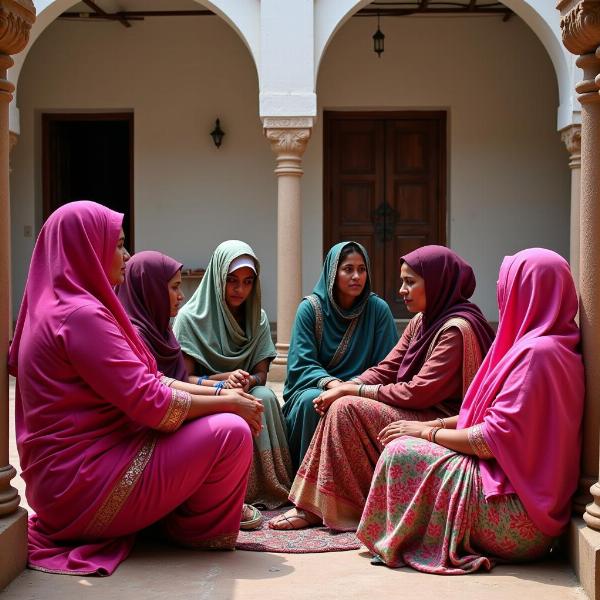Pardanashin, a word deeply embedded in Indian culture, often evokes images of veiled women and secluded lives. Understanding the true pardanashin meaning in Hindi requires delving into its historical and social context. This article explores the nuances of this term, examining its implications and evolution within Indian society.
Unveiling the Pardanashin Meaning: Beyond the Veil
The word “pardanashin” originates from the Persian words “parda” (veil or curtain) and “nashin” (seated or dwelling). In Hindi, pardanashin refers to a woman who remains secluded within the confines of her home, observing purdah, the practice of veiling and seclusion. While often associated with physical segregation, the concept extends beyond the literal veil. It encompasses a complex interplay of social norms, religious interpretations, and cultural expectations.
 Pardanashin women in India
Pardanashin women in India
Historical and Social Context of Pardanashin
The practice of pardanashin has a long and complex history in India, influenced by various factors including the arrival of Islam and pre-existing cultural norms. It became more prevalent during the Mughal era and was adopted by both Muslim and Hindu communities, although with varying interpretations and practices. Historically, pardanashin was sometimes seen as a marker of social status and respectability, particularly among the upper classes. However, it also limited women’s access to education, employment, and public life.
Evolution of Pardanashin in Modern India
In contemporary India, the practice of pardanashin is less common than in the past. Modernization, education, and changing social attitudes have contributed to a decline in strict adherence to purdah. While the literal veil might be less prevalent, the underlying concept of restricting women’s public participation persists in some communities. The interpretation and practice of pardanashin continue to evolve, reflecting the dynamic nature of Indian society.
The Impact of Pardanashin on Women’s Lives
Pardanashin has had a profound impact on the lives of women in India. While some view it as a form of protection and preservation of cultural values, others criticize it as a form of oppression that restricts women’s autonomy and opportunities. The practice has led to debates about women’s rights, education, and social mobility. Understanding the complex implications of pardanashin requires acknowledging the diverse perspectives and experiences of women within different communities and social strata.
Pardanashin in Literature and Popular Culture
The concept of pardanashin has been extensively explored in Indian literature, cinema, and other forms of media. These portrayals often depict the struggles and challenges faced by women living in seclusion, as well as the changing social dynamics surrounding the practice. Literary works and films have played a significant role in raising awareness and sparking discussions about the implications of pardanashin on women’s lives.
Frequently Asked Questions about Pardanashin
- Is pardanashin only practiced by Muslims? No, while commonly associated with Muslim communities, pardanashin has also been practiced by some Hindu communities in India.
- Is pardanashin still practiced in India today? Yes, although less common than in the past, the practice persists in some communities, often in modified forms.
- What are the reasons behind the practice of pardanashin? The reasons are complex and varied, ranging from religious interpretations to social status and cultural norms.
- What are the criticisms of pardanashin? Critics argue that it restricts women’s freedom, access to education, and opportunities for social and economic advancement.
- How has modernization impacted the practice of pardanashin? Modernization, education, and changing social attitudes have contributed to a decline in strict adherence to pardanashin.
pardanashin woman meaning in hindi
Conclusion: Navigating the Complexities of Pardanashin
Understanding the pardanashin meaning in Hindi requires acknowledging its historical context, social implications, and evolving interpretations within Indian society. The practice has shaped the lives of countless women, raising complex questions about cultural traditions, women’s rights, and social change. As India continues to evolve, the concept of pardanashin continues to be reinterpreted and debated, reflecting the ongoing dialogue about gender roles and societal norms.
separate entity meaning in hindi
Meaning-Hindi.in is your one-stop solution for all your Hindi translation needs. We offer a wide range of professional translation services, including business and commercial document translation, certified and legal document translation, technical and user manual translation, website and localization translation, educational and academic document translation, and express translation services. Our team of expert Hindi linguists ensures accurate and culturally sensitive translations. For all your translation needs, contact us at [email protected] or call us at +91 11-4502-7584. Meaning-Hindi.in is your trusted partner for bridging language barriers.